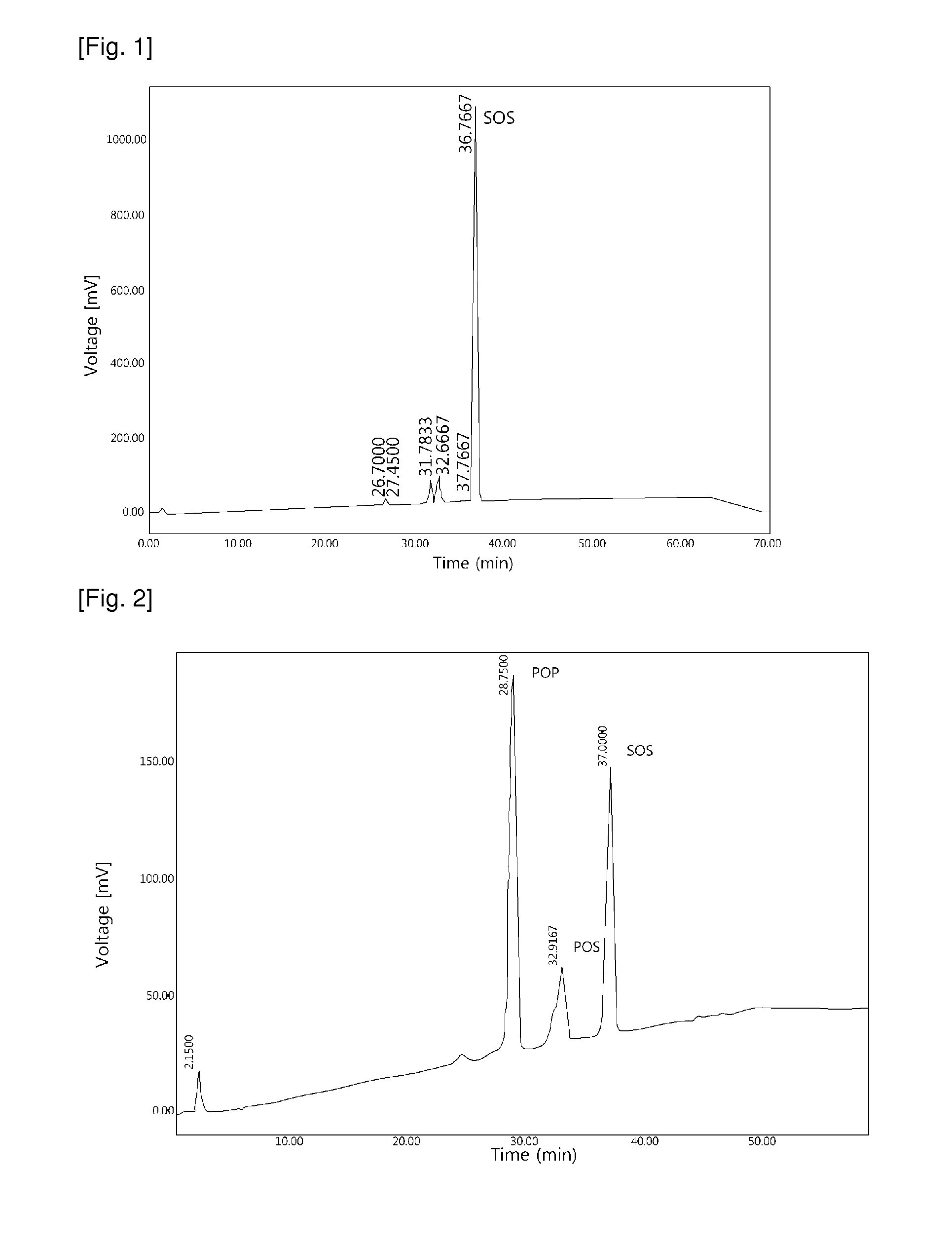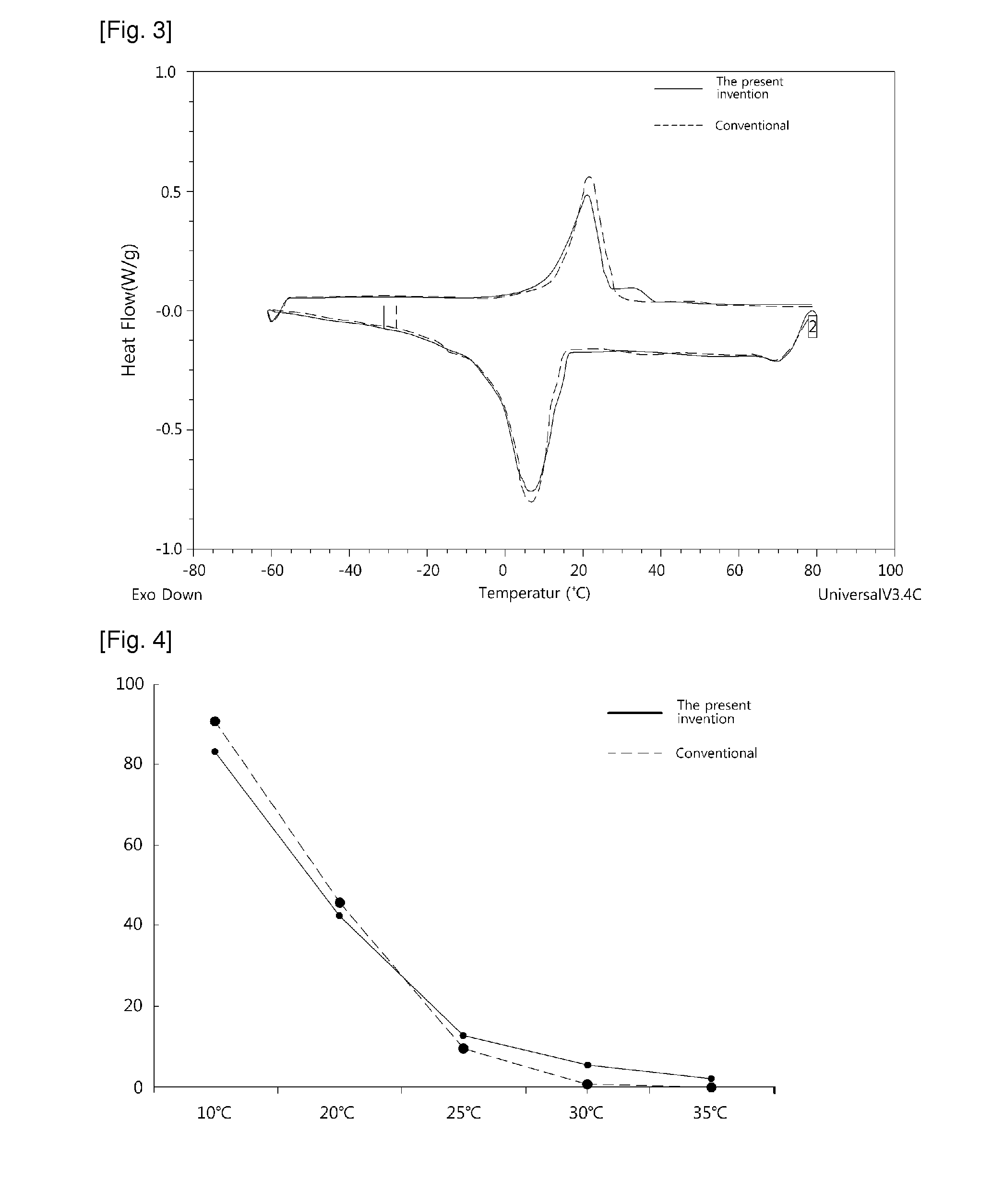Cocoa butter equivalents produced by the enzymatic interesterification process and method for preparing the same
a technology of enzymatic interesterification and cocoa butter, which is applied in the field of cocoa butter equivalents, can solve the problems of high fluctuation of price, high cost of natural cocoa butter, and inability to apply other techniques besides to expensive products, so as to improve yield and purity of reaction, the effect of convenient reaction process
- Summary
- Abstract
- Description
- Claims
- Application Information
AI Technical Summary
Benefits of technology
Problems solved by technology
Method used
Image
Examples
example 1
Selection of Enzyme
Lipozyme TLIM (Novozymes, Denmark) which is lipase from Termomyces Lanuginosus, is fixed into porous silica granule and is oil insoluble.
In the present example, TLIM and Lipozyme RMIM (Novozymes, Denmark) well known in the art were reacted with the same substrate in order to compare with their properties.
TABLE 1(area ratio: %)DGSOOSOSSSSTLIM1.432.4493.7RMIM14.434.2392.3DG: Diglyceride,S: Stearic acid,O: Oleic acid
As a result of the reaction, the activity of RMIM was lower than that of TLIM. As shown in the Table 1, in the composition of triglyceride in reactants after the reaction for 24 hours, RMIM contained more diglyceride than TLIM. Therefore, it can be known that TLIM is more stable and effective than RMIM in the respect of economical efficiency and conditions for the enzymatic interesterification.
example 2
Search for the Possibility of Interesterification by the Selected Enzyme
In the present example, batch reaction was carried out with a compound oil mixed hioleic oil with stearic acid in the molar ratio of 1:2 to 1:6 in order to search for the possibility of interesterification by the selected Lipozyme TLIM of the example 1. The reaction temperature was 45 to 50° C.
In order to verify reactivity by hexane solvent, assay for melting point according to reaction time and structure of triglyceride in oil was performed with or without the addition of solvent. And also, melting point before and after the interesterification with enzyme was measured with melting point apparatus, and an amount of SOS triglyceride structure in oil was measured with Reversed Phase Liquid Chromatography-Evaporative Light Scattering Detector. Melting point of process oil before the reaction was 25 to 28° C., and that of after the reaction was 29 to 32° C. As a the result of assay by the time, triglyceride structu...
example 3
Removal of Fatty Acid, Monoglyceride and Diglyceride by the Distillation
In the present example, unreacted fatty acid, ester and monoglyceride and triglyceride formed after reaction were removed from reaction oil prepared by the enzymatic interesterification with molecular distiller. The reaction was carried out at 1×10−3 mbar and 200° C. Amounts of monoglyceride and diglyceride in reaction oil after distillation should be below 1%. And also, the distilled fatty acid, ester et al. could be reused in the enzymatic interesterification through the dehydrogenation process.
PUM
 Login to View More
Login to View More Abstract
Description
Claims
Application Information
 Login to View More
Login to View More - R&D
- Intellectual Property
- Life Sciences
- Materials
- Tech Scout
- Unparalleled Data Quality
- Higher Quality Content
- 60% Fewer Hallucinations
Browse by: Latest US Patents, China's latest patents, Technical Efficacy Thesaurus, Application Domain, Technology Topic, Popular Technical Reports.
© 2025 PatSnap. All rights reserved.Legal|Privacy policy|Modern Slavery Act Transparency Statement|Sitemap|About US| Contact US: help@patsnap.com


